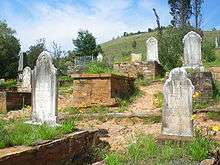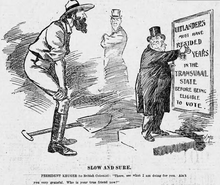Uitlander
Uitlander, Afrikaans for "foreigner" (lit. "outlander"), was a foreign (mainly British) migrant worker during the Witwatersrand Gold Rush in the independent Transvaal Republic following the discovery of gold in 1886. The limited rights granted this group in the independent Boer Republics was one of the contributing factors behind the Second Boer War.

Second Boer War

The vast Witwatersrand gold fields were discovered in 1886, and within ten years the uitlander population of the Transvaal was thought to be double that of the native Transvaalers, 60,000 uitlanders to 30,000 burghers.[1] These workers were primarily concentrated around the Johannesburg area.
The Transvaal government, under President Paul Kruger, were concerned as to the effect this large influx could have on the independence of the Transvaal. The uitlanders were almost entirely British. Enfranchising them, at a time when the British government was keen to extend its colonial power in South Africa, would almost certainly lead to power in the Transvaal passing into British hands, eventually turning it into a British colony. As a result, the Transvaal government passed a series of legislation in beginning in 1890 refusing voting rights or citizenship to any uitlander who had not been resident for fourteen years and who was over 40 years of age.[2] This successfully disenfranchised the uitlanders from any meaningful political role.
This policy, together with high taxation, gave rise to considerable discontent. Their treatment served as the pretext for the Jameson Raid in 1895; Cecil Rhodes planned an invasion of the Transvaal to coincide with an uprising of the uitlanders in Johannesburg. Dr Jameson's force invaded, but the expected uprising never took place; the invading force were quickly overpowered and arrested.
From 1897 onwards, the High Commissioner for South Africa, Sir Alfred Milner, and the Colonial Secretary, Joseph Chamberlain, used the denial of rights to the uitlanders as their main point of attack against the Transvaal. They encouraged uitlander agitation and pressed uitlander claims, with veiled threat of war, upon Kruger's government.
In the end, British insistence and Kruger's intransigence led to the outbreak of the Second Boer War in 1899.
Upon its defeat in 1902, the Transvaal became a British colony. All residents of the Transvaal thereafter became British subjects and so the term uitlander fell into disuse.
See also
Notes
- Exact figures are uncertain, as the first census of the Transvaal was not taken until April 1904. The Transvaal government made policy on the assumption that there were 60,000 uitlanders to 30,000 burghers (these figures refer to adult males only). This was a conservative estimate, others claimed the ratio to be 4:1 or even 10:1. Despite these figures, subsequent scholarship has suggested that there was in fact parity between the burgher and uitlander populations, although given the nature of mining there may have been more uitlander males. See JS Marias, The Fall of Kruger's Republic, p2)
- James Percy Fitzpatrick (July 1899). The Transvaal from Within. William Heinemann, London. p. 73-76.